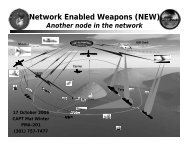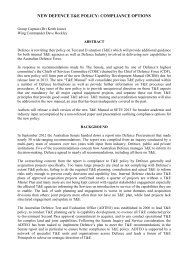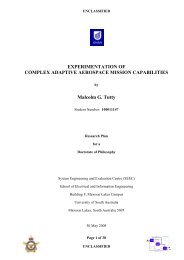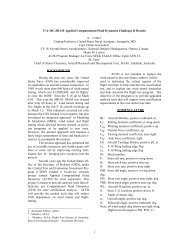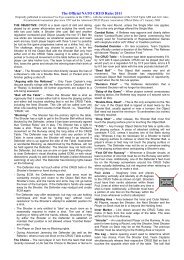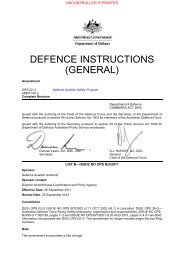MIL-HDBK-244A 6 apr 90.pdf
MIL-HDBK-244A 6 apr 90.pdf
MIL-HDBK-244A 6 apr 90.pdf
You also want an ePaper? Increase the reach of your titles
YUMPU automatically turns print PDFs into web optimized ePapers that Google loves.
<strong>MIL</strong>-<strong>HDBK</strong>-<strong>244A</strong><br />
5.1.5 Mechanical interface. The factors to be analyzed and<br />
examined, include but are not limited to those below, to determine the mechanical<br />
interface problem areas are as follows:<br />
(a) Stores characteristics- The stores functional or operational<br />
characteristics,mission objectives, and their integration into the<br />
aircraft systems should be examined to better identify all factors associated<br />
with a compatible installation of stores onto the aircraft. The attach<br />
mechanism, the functional controls, and the store configuration should be<br />
known to allow the engineer to perform appropriate trade-off studies to arrive<br />
at an optimum employment of the weapon.<br />
.<br />
(b) Store geometry and attaching hardware location -<br />
The store geometry and location of attaching hardware at the aircraft/weapon<br />
interface shall be designed to provide interchangeabilitybetween various<br />
types of aircraft and interserviceusage. The designer should consult the<br />
Allied Operations Publication (AOP-12) prepared by the Joint Ordnance<br />
Commanders Sub Group (JOCG). This manual will prove most useful in revealing<br />
possible interference between munitions or stores and the structures, pylons,<br />
bomb racks, etc. of the aircraft meant to carry them.<br />
-.. .“.<br />
(c) Carriage configuration- The development of the<br />
aircraft/weapon interfacemust take into considerationthe type carriage that<br />
will be incorporated into the aircraft, such as pylons, bomb bay, semi-submerged,<br />
or conformal. Shaping of the aircraft fuselage, control surfaces,<br />
and pylons are factors that must be coordinatedwith the suspension equipment<br />
and stores for proper system integration. Each discrete type of carriage<br />
must be adequately developed for maximum compatibilitywith existing and<br />
proposed suspension equipment and stores.<br />
(d) Weight distribution- The carriage configuration<br />
must be developed with,full considerationfor store weights distribution on<br />
the aircraft such that a full complement of stores or any partial load has<br />
minimal effect on the aircraft static margin limits. In addition, the carriage<br />
configuration mu’stbe developed recognizing that expensive and limited<br />
-availabilitystores mayneed to be returned to the airfield or aircraft if<br />
they are unused. The release sequence must also be evaluated to determine<br />
that normal release with possible random “hung” store, or stores, does not<br />
cause instability of the aircraft. Aircraft response and weapon dispersion<br />
effects should be assessed.<br />
(e) “Suspension equipment compatibility,-.The physical<br />
characteristicsof the suspension equipment must be known to the engineer to<br />
allow proper integration of the equipment to the ‘aircraftside of the interface.<br />
The ~hvsical characteristicsconsist of the external configuration of<br />
the suspens~ofiequipment, identifying size, shape, mounting holes-or provimaterials;<br />
sions; strength; stiffness; load factors; ejector force range<br />
connection locations; and access requirements. The aircraft “ nterface should “<br />
be compatible with requirements of <strong>MIL</strong>-A-8591.<br />
31<br />
Source: http://www.assistdocs.com -- Downloaded: 2009-07-16T13:55Z<br />
Check the source to verify that this is the current version before use.





